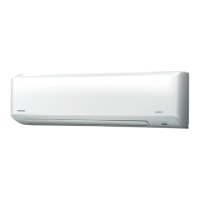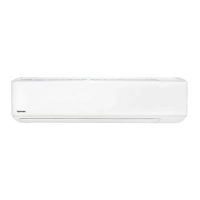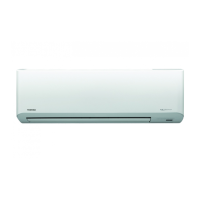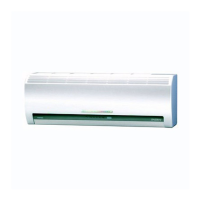Do you have a question about the Toshiba RAS-13N3KV-E and is the answer not in the manual?
Details specifications of indoor and outdoor units, including capacity, power, noise, dimensions, and weight.
Displays graphs showing compressor speed vs. current for cooling and heating modes.
Shows how cooling and heating capacity ratios vary with outdoor temperature.
Highlights safety precautions for handling R410A refrigerant during installation and servicing.
Covers requirements for piping materials, joints, and processing for R410A systems.
Details specifications for annealed copper pipes and minimum joint thicknesses.
Explains procedures and precautions for cutting, flaring, and connecting piping.
Provides detailed steps and precautions for flare pipe connections and tightening torque.
Lists tools exclusive for R410A and general tools required for installation and servicing.
Describes silver, phosphor bronze, and low-temperature brazing fillers for pipe joining.
Explains the necessity, characteristics, and types of flux used in brazing.
Outlines brazing methods, including prevention of oxidation and material compatibility.
Provides detailed diagrams and dimensions of the indoor unit components.
Presents diagrams and dimensions for the outdoor unit, including various views and connections.
Lists electrical parts for the indoor unit, including fan motor, sensors, and louver motor.
Details electrical components for the outdoor unit, such as reactor, fan motor, sensors, and compressor.
Provides operational data for cooling and heating, including temperatures, pressures, and speeds.
Illustrates the control block diagram for the indoor unit and its functions.
Shows the control block diagram for the outdoor unit, including inverter and various control circuits.
Provides an overview of the air conditioner's control system, roles of indoor/outdoor units.
Details various operation modes and control functions of the air conditioner.
Explains the auto restart feature, including how to set, cancel, and handle power failures.
Covers the functions of the remote controller, its display, and various operation modes.
Shows diagrams for the installation of indoor and outdoor units, including placement and connections.
Covers general installation aspects, including optional parts, accessories, and tools.
Details installation procedures specific to the indoor unit, covering placement, wiring, and fixing.
Guides the installation process for the outdoor unit, including placement, piping, and electrical work.
Covers additional installation procedures like gas leak testing, remote control setup, and test operation.
Steps to confirm initial conditions like power supply, voltage, and normal program operation.
Methods for primary diagnosis, including flashing LEDs, self-diagnosis, and symptom judgment.
Interprets flashing LED codes on the indoor unit to identify protective circuit operations.
Explains how to use the remote controller for self-diagnosis and interpret check codes.
Provides detailed steps on how to access and use the remote controller's service mode.
Offers cautions and procedures to follow after performing servicing and check codes.
Guides on diagnosing troubles based on symptoms, covering indoor and outdoor unit issues.
Provides troubleshooting steps for indoor unit issues like power failure and fan motor problems.
Addresses issues related to wiring failures, including outdoor unit operation and stopping.
Outlines methods to check main components like pulse motor valves and temperature sensors.
Provides methods for diagnosing problems within the outdoor unit's inverter assembly.
Details procedures for checking main parts like P.C. boards, sensors, and motors.
Guides on diagnosing the outdoor fan motor's condition based on symptoms and resistance checks.
Provides step-by-step instructions for replacing main parts of the indoor unit, like the front panel and electric parts box.
Details the procedure for replacing the microcomputer assembly in the indoor unit.
Explains how to detach and attach main components of the outdoor unit, such as cabinets and fan motor.
Shows an exploded view and parts list for the indoor unit, identifying components by location and part number.
Lists parts and their corresponding numbers for the indoor unit assembly.
Provides an exploded view and parts list for the outdoor unit, mapping parts to location and numbers.
Illustrates the P.C. board layout for the unit, showing component placement and connections.
Details specifications of indoor and outdoor units, including capacity, power, noise, dimensions, and weight.
Displays graphs showing compressor speed vs. current for cooling and heating modes.
Shows how cooling and heating capacity ratios vary with outdoor temperature.
Highlights safety precautions for handling R410A refrigerant during installation and servicing.
Covers requirements for piping materials, joints, and processing for R410A systems.
Details specifications for annealed copper pipes and minimum joint thicknesses.
Explains procedures and precautions for cutting, flaring, and connecting piping.
Provides detailed steps and precautions for flare pipe connections and tightening torque.
Lists tools exclusive for R410A and general tools required for installation and servicing.
Describes silver, phosphor bronze, and low-temperature brazing fillers for pipe joining.
Explains the necessity, characteristics, and types of flux used in brazing.
Outlines brazing methods, including prevention of oxidation and material compatibility.
Provides detailed diagrams and dimensions of the indoor unit components.
Presents diagrams and dimensions for the outdoor unit, including various views and connections.
Lists electrical parts for the indoor unit, including fan motor, sensors, and louver motor.
Details electrical components for the outdoor unit, such as reactor, fan motor, sensors, and compressor.
Provides operational data for cooling and heating, including temperatures, pressures, and speeds.
Illustrates the control block diagram for the indoor unit and its functions.
Shows the control block diagram for the outdoor unit, including inverter and various control circuits.
Provides an overview of the air conditioner's control system, roles of indoor/outdoor units.
Details various operation modes and control functions of the air conditioner.
Explains the auto restart feature, including how to set, cancel, and handle power failures.
Covers the functions of the remote controller, its display, and various operation modes.
Shows diagrams for the installation of indoor and outdoor units, including placement and connections.
Covers general installation aspects, including optional parts, accessories, and tools.
Details installation procedures specific to the indoor unit, covering placement, wiring, and fixing.
Guides the installation process for the outdoor unit, including placement, piping, and electrical work.
Covers additional installation procedures like gas leak testing, remote control setup, and test operation.
Steps to confirm initial conditions like power supply, voltage, and normal program operation.
Methods for primary diagnosis, including flashing LEDs, self-diagnosis, and symptom judgment.
Interprets flashing LED codes on the indoor unit to identify protective circuit operations.
Explains how to use the remote controller for self-diagnosis and interpret check codes.
Provides detailed steps on how to access and use the remote controller's service mode.
Offers cautions and procedures to follow after performing servicing and check codes.
Guides on diagnosing troubles based on symptoms, covering indoor and outdoor unit issues.
Provides troubleshooting steps for indoor unit issues like power failure and fan motor problems.
Addresses issues related to wiring failures, including outdoor unit operation and stopping.
Outlines methods to check main components like pulse motor valves and temperature sensors.
Provides methods for diagnosing problems within the outdoor unit's inverter assembly.
Details procedures for checking main parts like P.C. boards, sensors, and motors.
Guides on diagnosing the outdoor fan motor's condition based on symptoms and resistance checks.
Provides step-by-step instructions for replacing main parts of the indoor unit, like the front panel and electric parts box.
Details the procedure for replacing the microcomputer assembly in the indoor unit.
Explains how to detach and attach main components of the outdoor unit, such as cabinets and fan motor.
Shows an exploded view and parts list for the indoor unit, identifying components by location and part number.
Lists parts and their corresponding numbers for the indoor unit assembly.
Provides an exploded view and parts list for the outdoor unit, mapping parts to location and numbers.
Illustrates the P.C. board layout for the unit, showing component placement and connections.
| Type | Split System |
|---|---|
| Cooling Capacity | 3.5 kW |
| Heating Capacity | 4.0 kW |
| Refrigerant | R410A |
| Power Supply | 220-240V, 50Hz |
| Indoor Unit Weight | 9 kg |











